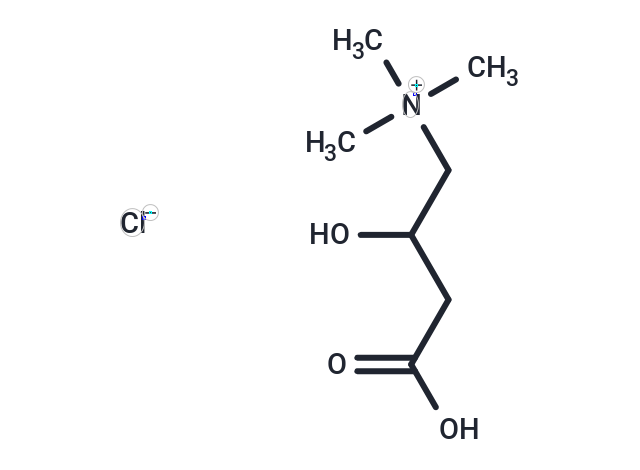Shopping Cart
- Remove All
 Your shopping cart is currently empty
Your shopping cart is currently empty

(±)-Carnitine chloride (Monocamin) is a quaternary ammonium compound biosynthesized from the amino acids lysine and methionine.

| Pack Size | Price | Availability | Quantity |
|---|---|---|---|
| 10 g | $29 | In Stock |
| Description | (±)-Carnitine chloride (Monocamin) is a quaternary ammonium compound biosynthesized from the amino acids lysine and methionine. |
| In vitro | L-carnitine primarily facilitates the translocation of long-chain fatty acids across the inner mitochondrial membrane by transforming acyl-CoA into acyl-carnitine via carnitine palmitoyl transferase (CPT)-I activation. This acyl-carnitine is then converted back into acyl-CoA within the mitochondrial matrix by CPT-II. L-carnitine's introduction enhances palmitoyl-CoA-induced mitochondrial respiration, further accelerated by ADP, showcasing a concentration-dependent effect that reaches saturation at 5 mM L-carnitine[1]. Additionally, L-carnitine pre-treatment enhances Nrf2 nuclear translocation, its DNA binding activity, and heme oxygenase-1 (HO-1) expression in Water2-treated HL7702 cells, providing protection against Water2-induced cell damage through Akt-mediated Nrf2 signaling pathway activation[2]. |
| In vivo | L-carnitine has been shown to modulate the ubiquitin-proteasome pathway and enhance IGF-1 levels in animal studies. Its administration over two weeks can mitigate muscle mass and fiber size reduction in the soleus muscle caused by hindlimb suspension. Additionally, L-carnitine inhibits atrogin-1 mRNA expression, crucial for preventing muscle atrophy. Concurrent L-carnitine treatment also reduces renal fibrosis—associated with lowered plasma TGF-β1 levels—and addresses the enhanced oxidative and inflammatory states observed in L-NAME treated groups, alongside promoting PPAR-γ expression. |
| Kinase Assay | Mitochondria (0.6 mg protein/mL) are incubated in 2.5 mM Hepes (pH7.4) containing 225 mM mannitol, 75 mM sucrose and 100 μM ethylene glycol tetraacetic acid (EGTA) with or without 5 mM L-carnitine at 25°C. To measure oxygen uptake, 10 min after inorganic phosphate (Pi) 4 mM are added, the mitochondria are treated with palmitoyl-CoA (50 μM) and then ADP is added (200 μM). Oligomycin (5 μM) and rotenone (10 μM) are added 3-4 min after the ADP treatment. HPG (0-10 mM), which can specifically inhibit carnitine palmitoyl transferase (CPT)-I activity in the mitochondria, is added in the Hepes medium before incubation of the mitochondria[1]. |
| Alias | Monocamin, DL-Carnitine HCl, DL-Carnitine chloride, Bicarnesine |
| Molecular Weight | 197.66 |
| Formula | C7H15NO3·HCl |
| Cas No. | 461-05-2 |
| Smiles | [Cl-].C[N+](C)(C)CC(O)CC(O)=O |
| Relative Density. | no data available |
| Storage | Powder: -20°C for 3 years | In solvent: -80°C for 1 year | Shipping with blue ice. | |||||||||||||||||||||||||||||||||||
| Solubility Information | H2O: 37 mg/mL (187.19 mM), Sonication is recommended. Ethanol: < 1 mg/mL (insoluble or slightly soluble) DMSO: 45 mg/mL (227.66 mM), Sonication is recommended. | |||||||||||||||||||||||||||||||||||
Solution Preparation Table | ||||||||||||||||||||||||||||||||||||
H2O/DMSO
| ||||||||||||||||||||||||||||||||||||

Copyright © 2015-2025 TargetMol Chemicals Inc. All Rights Reserved.